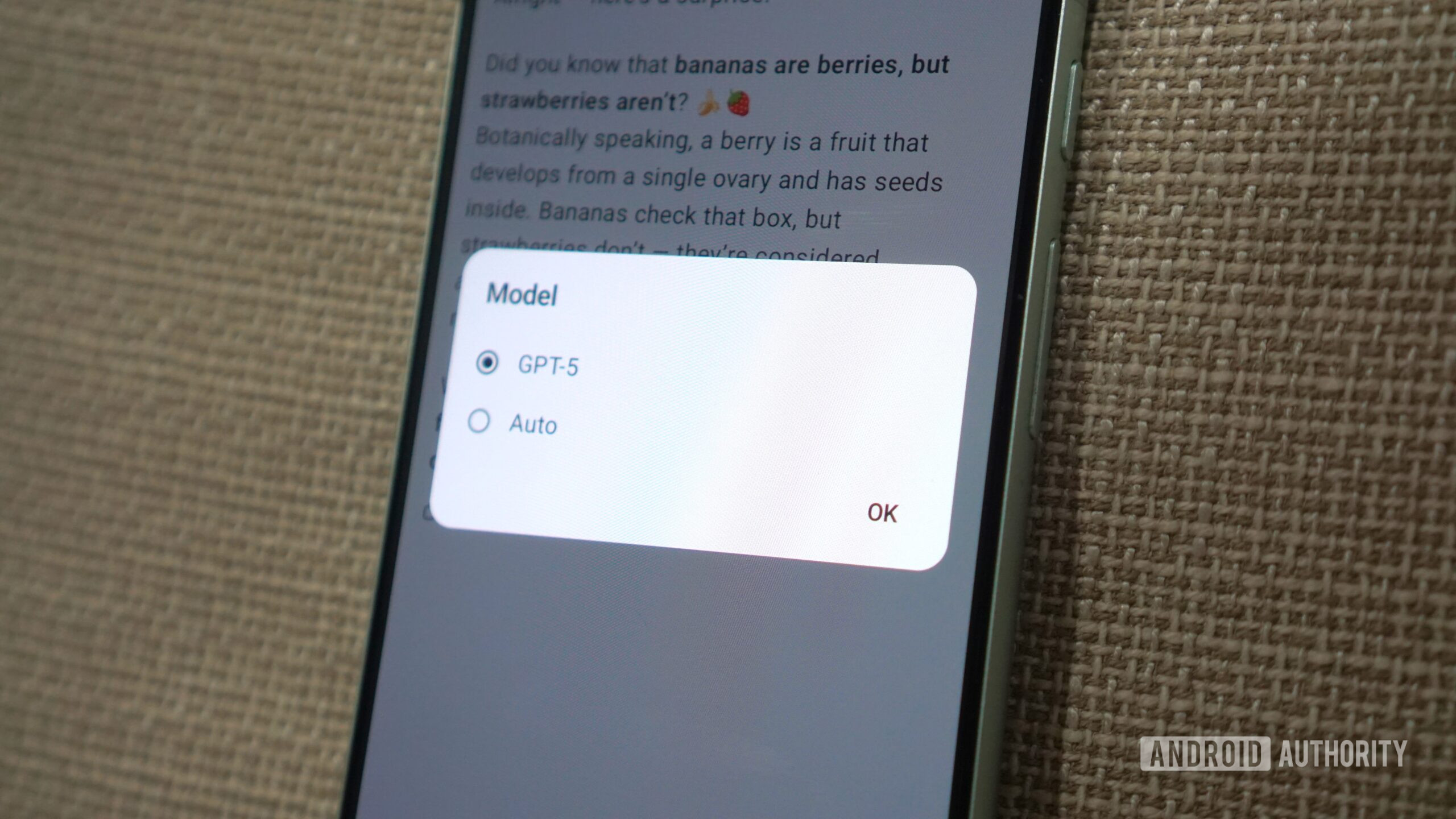Calvin Wankhede / Android Authority
After several leaks, Google has finally debuted its latest Gemini 3 family of large language models. The flagship model, Gemini 3 Pro, replaces the 2.5 Pro model that was first unveiled in March 2025. Google’s announcement comes hot on the heels of OpenAI’s GPT-5.1 model, which only released a week ago for all ChatGPT users.
Gemini 3 boasts better reasoning and multimodal capabilities. In fact, Google’s testing indicates that the new model beats OpenAI’s GPT-5.1 in almost every single AI intelligence benchmark. It’s also vastly better at coding as my colleague Mishaal showcased by building entire Android apps in little time.
Theoretical benchmarks aside, though, what’s actually new with Gemini 3 and how does it stack up against GPT-5.1 in the real world? I tested both AI models to find out.
Gemini 3 vs GPT-5.1: What’s new?
While most of Gemini 3’s quality upgrades are rather invisible, there are a few ways in which Google’s latest model offers a flat-out better experience than GPT-5.1. First off, Google is debuting what it calls “generative experiences”. Essentially, the AI model can now build animations and interactive UI interfaces right within your browser to explain complex topics.
The feature’s utility extends beyond educational content too. Google’s blog post showcased how Gemini 3 can generate rich “visual layouts” that you can interact with, complete with sliders, editable text fields, colorful tables, images, and other web elements. You can see a demo of this feature in the video below, where the chatbot generates a fully interactive interest rate calculator.
Google has also improved Gemini 3’s agentic capabilities. You could already ask Gemini to fetch information from your email or calendar, but the new model can handle multi-step commands too. For example, you can now ask the chatbot to book a car for your next trip and it will not only look through email but also browse the internet through a simulated browser to find an available car from a rental agency.
Gemini 3’s generative layouts feature is slowly rolling out to all users, but Google is only offering advanced agentic mode to AI Ultra subscribers for now. In other words, you’ll need to pay $200 per month for Google’s highest-end AI subscription for the feature.
Gemini 3 can perform real-world tasks on your behalf, but it’s not a free feature for now.
ChatGPT can also browse the internet via an Agent mode that was released earlier this year, and you don’t need a subscription to use it. However, the chatbot cannot read your email or access your calendar and reminders the way Gemini can. Google is also leading with the generative layouts feature, although you may not end up using it for most prompts.
As we’ve come to expect from new AI releases, you can use Gemini 3 for free but you will run into a rate limit after a few responses. GPT-5.1 follows a similar freemium policy, and both chatbots have a $20 monthly paid tier that increases response limits. The good news is that you’re not missing out on much even as a free user. Almost all of Gemini 3 and GPT-5.1’s features are available without a subscription.
Gemini 3 vs GPT-5.1: Why I still prefer ChatGPT

Calvin Wankhede / Android Authority
New features aside, Google’s benchmarks show Gemini 3 edging GPT-5.1 in response accuracy and intelligence. However, unless you ask both models scientific or reasoning-based questions, chances are that you will not notice a significant difference in their outputs.
Having said that, I do prefer GPT-5.1 in one area: model variety. Google has only rolled out one variant of Gemini 3 in the app: Gemini 3 Pro. And even though the app’s model selector dropdown offers two choices: “Thinking” and “Fast,” the latter still relies on the older Gemini 2.5 Flash model.
I could already notice the difference between the 2.5 Pro and Flash models last week, so it’s not surprising that the gap is even wider with the release of Gemini 3. For instance, when I asked how much raw pasta I should use for 500g of Italian sausage and 600ml of jarred sauce, the new model took roughly twenty seconds to think but came up with a comprehensive answer. Specifically, it gave me three different options depending on my preferred outcome: dry, saucy, or extra saucy pasta. On the other hand, the Fast model simply recommended using 400g of dry pasta. That answer’s technically correct but it wasn’t as helpful as Gemini 3’s response. So in case you were wondering, there is absolutely a quality difference between the older and latest models.
The solution may seem simple: just use Gemini 3 Pro all of the time. However, this quickly becomes a problem in longer conversations where you’ll face a ten to twenty second delay for each response. If you select the Thinking model, the chatbot is forced to pause and think before responding.
For a simple follow-up, clarification, or summary, I don’t need the chatbot to ponder — a smaller model would likely work just fine and give me instant responses, but I would have to manually fiddle with the model selector to make that happen.
ChatGPT handles model selection in a much more seamless fashion. As part of GPT-5, OpenAI developed a model router that intelligently forwards your prompt to the appropriately-sized model. GPT-5 has multiple model sizes in the backend, such as gpt-5-thinking and gpt-5-thinking-mini, but you don’t have to pick one.
If you ask ChatGPT a complicated question, you’ll see it pause and think for a few seconds before responding. But if you ask a simple follow-up question, it will respond instantly by using the general-purpose GPT-5.1 model. You can also ask ChatGPT to “think harder” if you don’t want to rely on the router. By contrast, Gemini 3 will always initiate a 200-word internal monologue even if I respond with a simple “Ok”.

Calvin Wankhede / Android Authority
Gemini thinks too much for its own good
There is good news, though. We’re talking about the same company that dedicated copious engineering time to deliver search results as quickly as possible in previous decades. And surprise surprise, Google is adding Gemini 3 to AI Mode in its search engine where it will decide if your query is complex enough to demand this cutting-edge model.
But for now, the Gemini app doesn’t copy GPT-5’s best feature – you have to choose your desired model manually and ahead of time. If you don’t, you suffer with either worse quality responses or longer wait times.
ChatGPT’s model router keeps me hooked on GPT-5 for longer conversations, but Google is working on a solution.
Until that changes, I’ll remain partial towards GPT-5.1 over Gemini 3. Even if Google releases a faster 3.0 Flash model, I wouldn’t want to switch between models all the time. The default ChatGPT experience strikes the perfect balance between reasoning and response time, and you don’t have to think about it. I suspect you’ll feel the same way if you tend to have longer conversations with AI chatbots.
As a complete package, however, I do believe that Gemini 3 has the potential to be more useful than GPT-5.1 due to its sheer prevalence. Gemini’s tight integration with Android, Google Search, and smart home products like speakers have made it my default AI assistant almost everywhere. It’s only in the rare instances when I want to sit down and converse with a chatbot that I actively seek out ChatGPT.
Thank you for being part of our community. Read our Comment Policy before posting.










